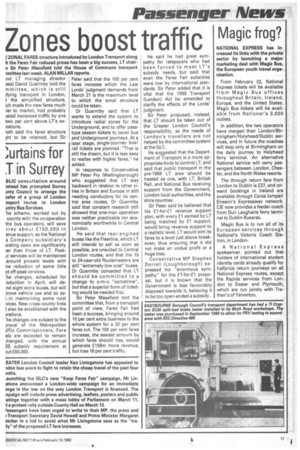Zones boost traffic
Page 15

If you've noticed an error in this article please click here to report it so we can fix it.
E ZONAL FARES structure introduced by London Transport along h the Fares Fair reduced prices has been a big success, LT chairn Sir Peter Masefield told the House of Commons transport nmittee last week. ALAN MILLAR reports.
t the simplified structure, ich made the new fares much ier to market, had probably asted increased traffic by one two per cent above LT's extat ions.
loth said the fares structure jilt to be retained, but Sir Lords' judgment demands from March 21 is the maximum level to which the zonal structure could be taken.
Dr Quarmby said that LT wants to extend the system to introduce radial zones for the Underground, and to offer passtype season tickets to cover bus and Underground journeys. At a later stage, single-journey bus/ rail tickets are planned. "That is still the dream, but it is less easy to realise with higher fares," he added.
In response to Conservative MP Peter Fry (Wellingborough) who suggested that LT was backward in relation to other cities in Britain and Europe in still needing conductors for its central area routes, Dr Quarmby said that constant research still showed that one-man operation was neither practicable nor economically worthwhile in Central London.
He said that rear-engined buses like the Fleetline, which LT still intends to sell as soon as possible, are unsuited to Central London routes, and that the 15 to 24-year-old Routemasters are still "extremely low cost" buses. Dr Quarmby conceded that LT should be committed to a change to o-m-o "sometime", but that a superior form of ticketing would be needed first.
Sir Peter Masefield told the committee that, from a transport point of view, Fares Fair had been a success, bringing around 10 per cent extra business to the whole system for a 32 per cent fares cut. The 100 per cent fares increase, the easiest amount by which fares should rise, would generate £156m more revenue, but lose 18 per cent traffic. He said he had great sympathy for ratepayers who had been forced to meet LT's subsidy needs, but said that even the Fares Fair subsidies were low by international standards. Sir Peter added that it is vital that the 1969 Transport (London) Act be amended to clarify the effects of the Lords' judgment.
Sir Peter proposed, instead, that LT should be taken out of the Greater London Council's responsibility, as the needs of London's travellers are not helped by the committee system at the GLC.
He suggested that the Department of Transport is a more appropriate body to control LT, and said that public transport in the pre-1969 LT area should be treated as one, with LT, British Rail, and National Bus receiving support from the Government, London local authorities, and the shire counties.
Sir Peter said he believed that his £1-for-£1 revenue support plan, with every £1 earned by LT being matched by £1 support, would bring revenue support to a realistic level. LT would aim its fares to a level just above breakeven, thus ensuring that it did not make an undue profit or a huge loss.
Conservative MP Stephen Dorrell (Loughborough) expressed his "enormous sympathy" for the £1-for-£1 proposal, but it is known that the Government is less favourably disposed towards it, believing it to be too open-ended a subsidy.
















































